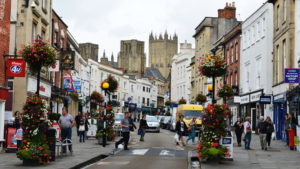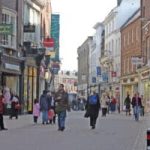
The number of visitors to shopping destinations dropped back last week in one of the first indications of a slowdown in spending amid rising energy bills.
In the week beginning 2 October, footfall slipped by 0.2% on the previous week across all UK retail destinations, with the biggest drop in shopping centres and retail parks, according to figures from the monitoring group Springboard.
Diane Wehrle, the insights director at Springboard, said there had been a drop in almost all parts of the UK – in some areas by more than 2% – which she said “may well be an initial indicator” of the impact on consumers of higher energy costs that came into effect on 1 October.
About 38% of shoppers identified themselves as ‘distressed’ and at a high risk from the soaring cost of living.
“This is a clear contrast to the week before last, when footfall rose universally across all areas of the UK,” she said.
The week-on-week drop in footfall comes at a time of year when the number of people shopping is usually beginning to rise in the run-up to the peak Christmas spending period.
Instead, there is evidence that UK shoppers are beginning to cut back on the number of items they are buying in an effort to offset higher prices.
Sales rose 2.2% in September, according to the British Retail Consortium (BRC) and the advisory firm KPMG, indicating a decline in volumes as inflation hit almost 10%.
The main cutbacks were on non-food items, with spending down by 0.4% last month, according to the BRC, as spending on food rose 4.6%, driven largely by inflation.
Helen Dickinson, the chief executive of the BRC, said that consumers were “shopping cautiously” and particularly avoiding expensive products such as computers, TVs and furniture. She said many households are also preparing for higher energy costs this winter by purchasing blankets and energy-efficient appliances, such as air dryers and air fryers.
She said: “A difficult winter looms for both retailers and consumers. Costs are increasing throughout retailers’ supply chain, the pound remains weak, interest rates are rising, and a tight labour market is pushing up the cost of hiring. All of this is making it harder for retailers to reduce prices and help struggling households.”
Households also made particularly sharp cutbacks on clothing and dining out last month – by about 4% and 12% respectively, according to data from the UK’s largest credit and debit card operator, Barclaycard.
Its card users increased spending on non-essentials by only 1% last month, despite the double-digit inflation – suggesting a marked shift towards making economies from August, when spending on non-essentials was up 3.6%.
Barclaycard also flagged a shift towards staying in, with spending on takeaways up 10% and the first rise in payments on subscriptions, gaming and sports streaming (1.6%) for many months.
Shoppers are also cutting back on essentials such as the weekly grocery shop, so overall card spending rose only 1.8% last month, the lowest increase since February last year when the UK was still in lockdown.
Esme Harwood, a director at Barclaycard, said: “Energy price increases are understandably causing concern for Brits, as they worry whether they will have enough money to cover their household bills.
“Consumers are taking a savvy approach to budgeting as they reduce spending on discretionary items and seek more value in their weekly shop, which is having a knock-on effect on retail and hospitality sectors.”
More than half of consumers said they were planning to cut back on non-essential spending in order to afford higher energy bills, according to Barclaycard, as its card holders spent 48% more on utilities last month.
Retailers – including the bosses of Marks & Spencer, Next and Asda – have warned of a downturn in consumer spending this autumn and into next year as households struggle with higher energy and food bills.
Shoppers are expected to spend £4.4bn less – 20% down on last year – on non-essentials in the last three months of the year, when most retailers book the majority of profits, according to research by Retail Economics with the retail technology firm Metapack.
However, Wehrle noted that it could be too early to draw firm conclusions about behaviour because the worst drop in footfall was on Wednesday, when the weather was markedly worse than the previous week.
Visitor numbers remain up on last year, when the UK was enjoying a return to normality between the early summer pandemic lockdowns and December restrictions linked to the Omicron variant.
High streets have experienced the biggest bounceback from last year – with visitor numbers up by just over 7% – contributing to a 5.1% uplift across all shopping destinations.
However, shopper numbers remain almost 11% down on pre-pandemic levels, with central London and regional cities particularly hard-hit – down 17.4% and 14.2% respectively.
Meanwhile, the Post Office has noted an increase in the use of cash as households attempt to manage their budget on a weekly or daily basis.
Read more:
UK retailers hit by drop in footfall as energy bills rise







